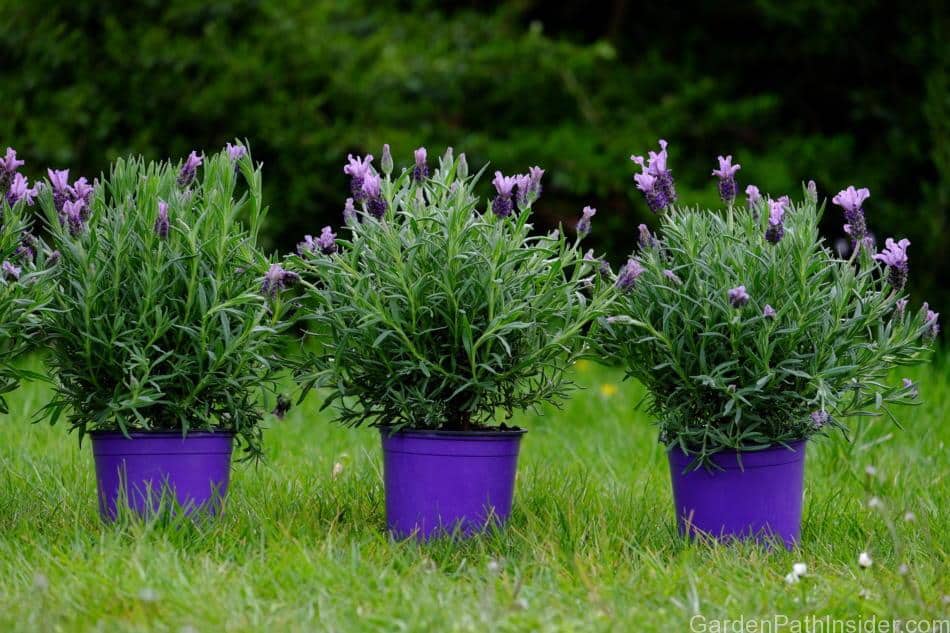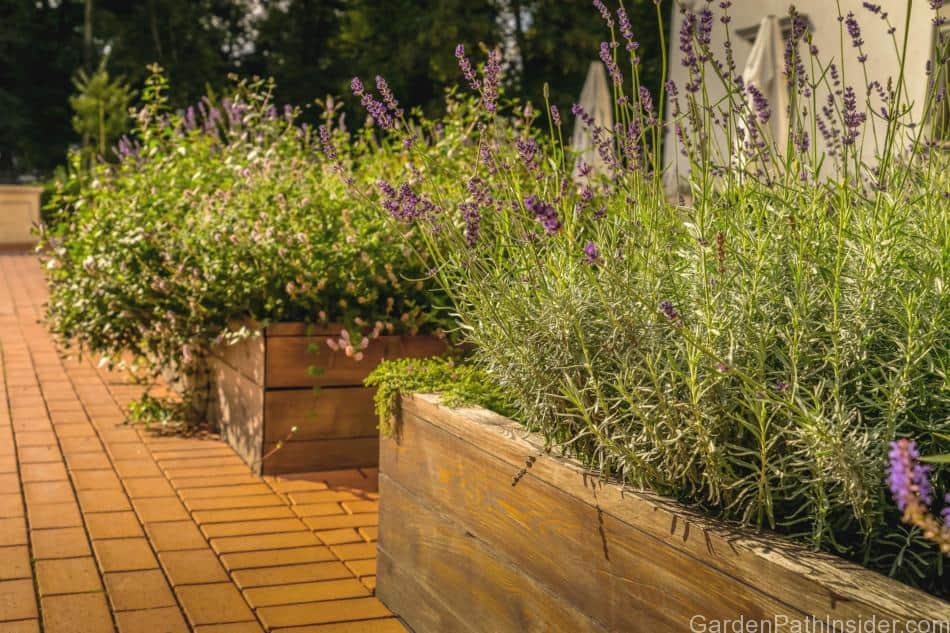
Lavender is a great plant to grow in an indoor container garden. The lavender plants are hearty and withstand dry hot conditions, while still providing beautiful purple flowers with grayish-green leaves and a fragrance that is so relaxing it is used in meditation candles and essential oils.
Lavender can be grown indoors in container gardens and requires a well-draining soil that is neutral to mildly alkaline. Place the lavender plant in a window that gets direct sunlight for at least 4 to 6 hours per day. Keep the plant at a temperature above 60°F (15.5°C) during the day, and keeping nighttime temperatures above 40°F (4.4°C).
Lavender is a fun and fragrant plant to grow indoors and can be used in homemade crafts to delicious beverages. Get started on your indoor lavender garden and read below to pick the perfect lavender variety for your growing space.
Selecting a Variety of Lavender
The first step to building your lavender container garden is selecting the right variety for your growing area. There are dozens of species of lavender with several hundred varieties, ranging from small varieties that only grow 10 inches tall (25cm) to large varieties that are grown in world famous lavender farms.
Below are some of my favorite varieties to grow in gardens with limited available space.
Thumbelina Leigh Dwarf English Lavender: A small variety of lavender that blooms summer to fall, with a maximum growing height of about 1 foot (30cm). This lavender has the traditional purple lavender colored flowers and is recommended to plant in a pot at least 4 inches (10cm) in diameter and 4 to 6 inches deep (10 to 15cm). This small variety of lavender is a great way to enjoy the colors and fragrances of lavender when growing space is limited.
Blue river Lavender: A variety of lavender that blooms summer to fall, with a maximum growing height of about 14 inches (35cm). The flowers of this lavender are traditional purple color and are recommended to plant in a pot at least 4 inches (10cm) in diameter and 4 to 6 inches deep (10 to 15cm). This variety of lavender is able to tolerate hot and dry conditions very well.
Mini blue lavender: A small drought-resistant variety of lavender that grows to the height of about 1 foot (30cm). Mini Blue is great for container gardens and provides beautiful blooms of purple flowers against the plant’s grayish-green leaves.
Container Needs for Indoor Lavender
For your indoor container garden, use a pot with a diameter of 4 to 8 inches (10 to 20 CM) larger than the lavender plant root cluster. If the pot is too small the roots will get congested and the growth of the plant will be stunted, requiring the lavender to be transplanted to a larger pot.
If you plant lavender in a pot that is too large then the risk of waterlogging the root system increases as more soil will hold moister for a longer period. Too much water in the pot will cause the roots to rot.
Clay pots are my first choice for plants grown inside or outside. The clay pots are porous enough to let excess water permeate through the clay pot, avoiding standing water in the root system. Be careful as you can still overwater plants in clay pots if not careful.
Clay pots usually have one large drainage hole in the center bottom of the pot. Your planting containers will need adequate drainage holes to allow excess water to drain through the soil.
If you are using a plastic planting container you may have to drill out a few holes in the bottom of the container; make sure they are large enough to not get clogged by the soil.
Place a small barrier inside the pot over the drainage hole to prevent the soil and roots from blocking the drainage ports. I use pieces of broken clay pots to protect the drain holes, but you can also use a few small rocks (not pebbles), or mesh wire. Do not block the hole, just lay the objects over the drain ports.
Always add a drip tray under an indoor container plant to let the excess water run through the plant and then reabsorb as needed later in the day.

Soil Needs for Lavender
Lavender requires a well-draining soil that is neutral to mildly alkaline. Lavender is native to the Mediterranean and thrives in lower to moderately fertile soils.
In containers and pots, I have found lavender grows best when the soil does not have added compost or organic food matter. I have successfully grown lavender in sandy topsoil I pulled from my backyard and, I have used store-bought soil. Both types of soil have worked well, the key is the soil must drain thoroughly and not hold excessive amounts of water.
Watering Requirements for Lavender
Lavender plants are native to the Mediterranean and thrive in the dry air and can tolerate dry soil conditions caused by droughts. Lavender grown inside can thrive with adequate watering and withstand the dry air conditions that occur in the home, especially during the winter months when the heaters and fireplaces are roaring.
When watering the lavender plant use enough water to thoroughly saturate the soil. Be careful to not overwater lavender. Only water when you feel the soil is beginning to get dry. If the soil is damp your lavender does not need water.
If the leaves start to droop or change color AND the soil is moist, then your planting container may be holding too much water causing the roots to slowly rot. Water thoroughly as needed checking the soils moister levels daily.
When growing plants in pots I always place the pot on a dish or tray to collect the water that runs through the plant after watering, I do this for both indoor and outdoor plants.
The tray under the planting pot or container will collect the water that runs through the soil when watering, then the water sitting in the tray stays available for the plant to re-absorb later as needed.
Check the soil daily by pressing your finger in the soil a few inches away from the base of the plant. Keep the soil damp for the best growing conditions for the lavender plant. Soil that is too muddy and watery will cause the roots to rot, and soil that is too dry will stunt the plant’s development.
Make sure to not damage the root system while you are checking the plant’s water levels. A light press on the soil will tell you everything you need to know about the plant’s hydration status.
Fertilizing Lavender Plants
Lavender plants grow successfully in low fertile soil. I do not use fertilizer the first season I plant lavender in pots, as too much fertilizer can burn the roots and injure the plant’s growth.
Lavender is a perennial and at the end of the growing season the leaves and flowers growing above the dirt will die and dry out. At the end of the growing season, the roots are still alive, but they are preparing to go dormant for the winter and will not produce any more growth for the season.
I fertilize my lavender plants during the following spring when the new growth is breaking through the soil. There are several types of fertilizers on the market. You will want to research the specific variety of lavender to identify its fertilizing needs based on its growing conditions.
Sunlight Needs for Lavender
- Lavenders’ optimal sunlight exposure is 6 to 8 hours per day.
- The plant will require a minimum of 3 hours of sunlight per day.
- Keep the potted lavender several feet distance from direct heat, keep away from hot ovens, cooktops, space heaters, and heated air ducts.
- Keep the temperature above 60°F (15.5°C) during the day and keep nighttime temperatures above 40°F (4.4°C)
Thank you for visiting our resource!
Cover image: Lavender plant in a flowerpot_© tweety1104/123rf.com
